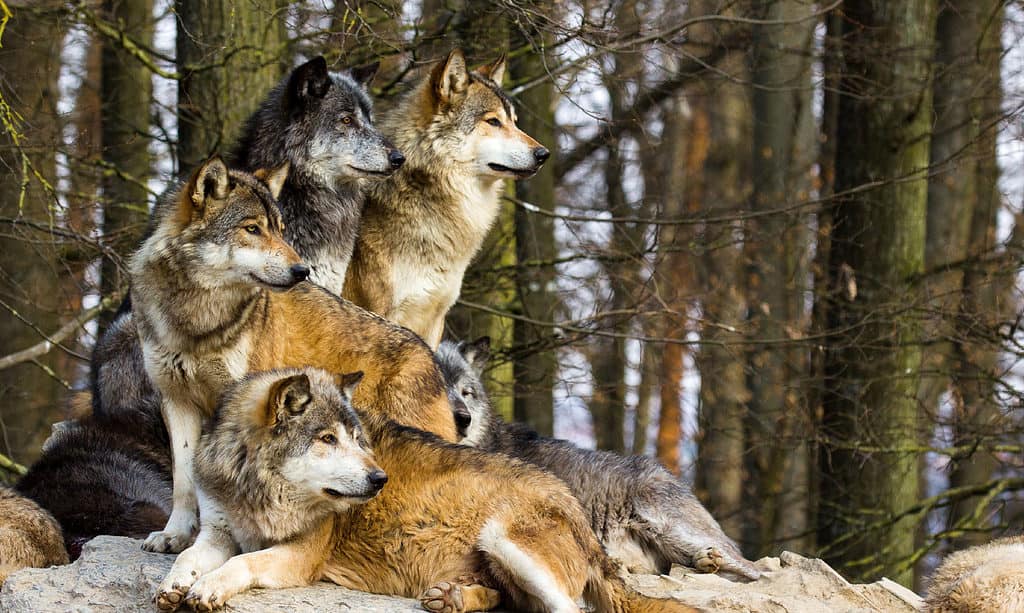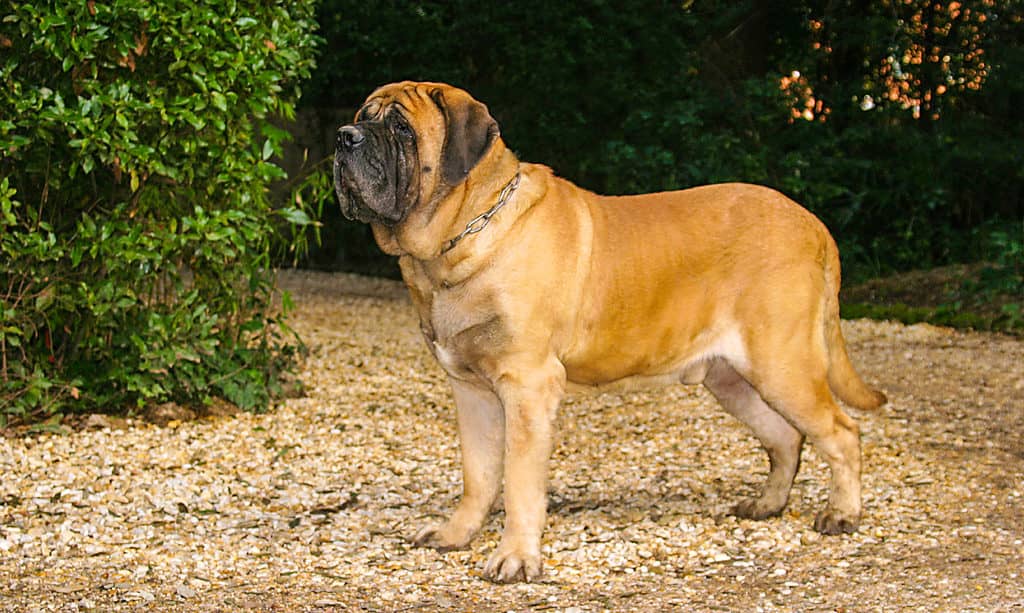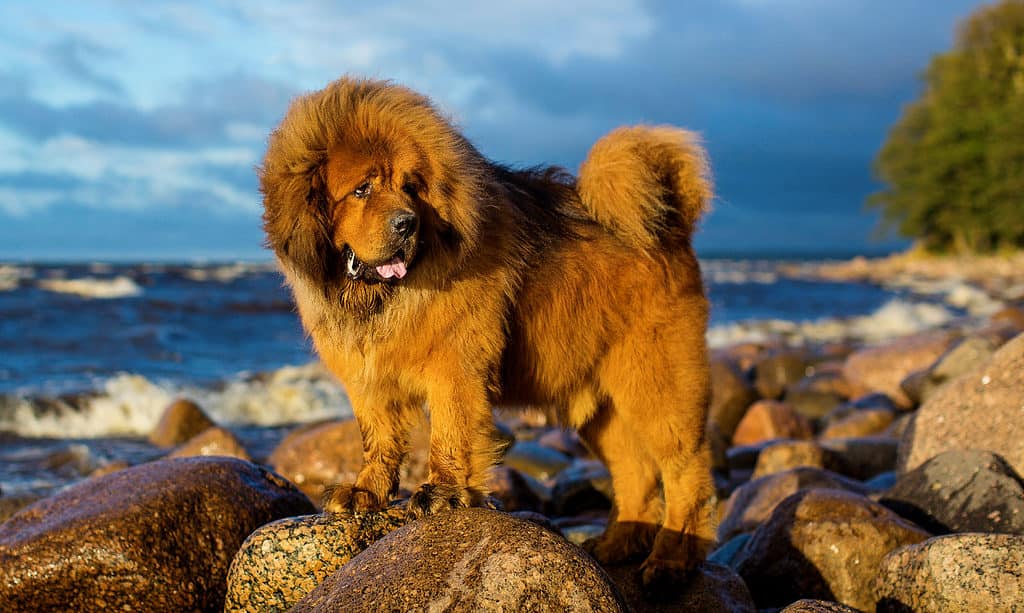When someone sees a mastiff, their first thought is likely something to do with the dog’s immense size! These giants of the pet world were certainly not bred to be lap dogs. Dogs and humans have a long history of working together, which is true with mastiffs. They have had many important roles throughout history and still serve humans today. This article will explore what mastiffs were bred for and all the jobs they have had over the millennia.
When Did Domestic Dogs Evolve?

Domestic dogs are descendants of wolves.
©iStock.com/Cloudtail_the_Snow_Leopard
The first members of the dog family, Canidae, appear in the fossil record 40 million years ago! Domestic dogs, Canis familiaris, are direct descendants of gray wolves, Canis lupus. The two canine species diverged only 130,000 years ago- not very long! Due to their close evolutionary history, domestic dogs still retain many traits similar to those of wolves. Breeding and human selection, however, has led to tremendous variation and diversity in domestic dogs. Even though a chihuahua looks very different from a Great Dane, they are still the same species!
What Are Mastiffs?

Mastiffs are large dogs.
©Ricantimages/Shutterstock.com
In 1800, the famous natural history illustrator Sydenham Edwards said, “What the lion is to the cat, the mastiff is to the dog.” The term “mastiffs” describes a group of very large dogs of several distinct breeds. They are often considered to be the largest dogs in the world! The largest breed, the English mastiff, can weigh between 160 to 230 pounds. On average, the English mastiff stands 30 inches tall. The smallest mastiff breed is the Himalayan mastiff, also known as the Himalayan sheepdog. On average, they weigh between 51 and 90 pounds. They are also shorter than English mastiffs, standing at 20-26 inches.
Some breeds of mastiffs still alive today are the English mastiff, Spanish mastiff, Tibetan mastiff, Himalayan mastiff, Neapolitan mastiff, South African mastiff, Danish mastiff, bullmastiff, Indian mastiff, Italian mastiff, French mastiff, Brazilian mastiff, Kurdish mastiff, Pyrenean mastiff, Majorcan mastiff, and South American mastiff. There is disagreement, however, regarding if some of these breeds qualify as distinct breeds according to the American Kennel Club.
How and When Were Mastiffs Bred?

The Tibetan mastiff is thought by some to be the ancestral breed of all mastiffs.
©Kat_marinina/Shutterstock.com
Although it is not certain, the Tibetan mastiff is thought by some to be the ancestral breed of all mastiffs. One of their early uses was by tribes in Tibet to protect livestock from wolves and bears. Some studies even suggest that the Tibetan mastiff was the first breed of domestic dog! Mastiffs appear in Asian records as far back as 3000 B.C.! Other theories claim that the Tibetan mastiff is not the ancestral breed and that the ancestor was originally a British breed.
What Were Mastiffs Bred For?

Most commonly, mastiffs were bred to be guard dogs which is still often seen today.
©iStock.com/ericv
Mastiffs have served humans in many roles because of their massive size. Most commonly, mastiffs were bred to be guard dogs which is still often seen today. They protect land, livestock, and other property, and can take down humans and large animals. Mastiffs have also been bred for war, hunting, and blood sports- fighting other dogs or large animals for human entertainment.
Guard Dogs
Mastiffs were originally bred to be guard dogs. They are innately intimidating due to their massive size and are extremely powerful in action. They also have notably bold, watchful, and territorial behavior that makes them extremely vigilant. Interestingly, mastiffs have such a reputation as guard dogs that the term “bandog” – which means a dog secured by a chain- is used interchangeably with the word “mastiff” in old English literature.
The Tibetan mastiff is arguably the best breed of guard dog. Originating in the Himalayas, they have a long history of protecting large herds of livestock, as well as people and property, in harsh conditions. The bullmastiff is also a valid contender. They are a crossbreed between English mastiffs and old English bulldogs from the early 1900s. They were bred for speed, strength, and size and their common use by gamekeepers earned them the nickname the Gamekeeper’s Night Dog. Neapolitan mastiffs are also popular for this job and come from a distinguished line of traditional guard dogs originating from central Italy.
War Dogs
In war settings, mastiffs have been trained as scouts, sentries, messengers, mercy dogs, and trackers. Dogs of various breeds were so prolific in World War I that the Imperial War Museum theorizes over 16 million animals were in service. Mastiffs specifically are also known to have fought alongside the Romans and British in the Roman Conquest of Britain in 43 C.E. The earliest mention of English mastiffs in English records is in 55 B.C. noted by Caesar to be present during his invasions.
Sentries
The main jobs of a sentry dog were to keep watch at camps and act as guard dogs during wartime. Often, sentry dogs sat with soldiers on guard and could alert them when trouble was near before the soldier may have sensed it themself. Mastiffs’ innate territorial behavior and vigilance lent to their abilities as sentries throughout history and were critical to protecting troops and warning them of incoming threats. Ancient societies that used war dogs as sentries include the Romans, Greeks, Persians, Egyptians, Sarmatians, Baganda, Alans, Britons, and Slavs.
Trackers and Scouts
Tracker dogs also have a long history in wartime and are still important today. They are used to find explosives, weapons, ammunition, and people. The United States Army used scout dogs in World War II and the Korean War. In the Vietnam War in 1966, the U.S. Army attempted to train dogs to use in Combat Tracker Teams to find Vietnamese guerrillas and insurgents. Several breeds of dogs, including Labrador retrievers, German shorthaired pointers, Vizslas, golden retrievers, and others are also common explosive-detecting dogs, but mastiffs are not as often seen in this role.
Mercy Dogs
Mercy dogs, also called ambulance dogs, were trained to find lost and wounded soldiers, and carry water, liquor, and first aid supplies to them after a battle. They served in this role most prominently in World War I and World War II. If a soldier on the same side as the dog was severely wounded and could not use the supplies from the dog to tend to his wounds, the mercy dog could also help medics find the wounded. If a soldier needed more serious medical attention, the mercy dog would rip a piece of the soldier’s uniform and bring it to the medics at base camp. Then, the dog could lead the medics to the soldier. In some circumstances, mercy dogs could also drag wounded soldiers to safety. Mercy dogs were trained to identify and ignore enemy soldiers and dead bodies.
Messengers
During World War I, several dog breeds, including mastiffs, were messenger dogs. Messenger dogs were critical to most European armies for transporting supplies and messages during wartime- even when under fire. Today, advanced technology can perform these duties; however, before this was available, the use of messenger dogs greatly reduced the number of human casualties to warfare and were crucial assets to several nations. They could be trained to travel incredible distances to return to one or two handlers or keepers. This allowed them to carry messages and supplies from base camp to the front lines of battle.
Dog Fighting
Dog fighting is known to have occurred as early as ancient Roman times. Mastiffs were popular breeds to use for blood sports because of their tremendous size and strength. The dogs would be forced to fight against other dogs and against large wild animals. Fighting dogs were bred selectively for traits collectively called “game” or “gameness”, meaning inclination toward aggressive and persistent behaviors despite the risk of substantial injury or death. Today, dog fighting is illegal in most countries but remains popular, for example, in Russia. It is still legal in some countries such as Honduras, Japan, and Albania. In China, dog fighting is illegal, but only if there is gambling involved.
Hunting Dogs
Mastiffs have been utilized as hunting dogs in the past but are not common in the sport today. Although they are strong dogs, they lack the endurance and the prey drive of more successful hunting breeds such as Labrador retrievers, beagles, Irish setters, bloodhounds, and others. English mastiffs, however, were reportedly shipped out of Britain for game hunting during the first century. Due to their size, they could take down large game in addition to tracking them. Tibetan mastiffs, for example, have been used to hunt bears! However, they are not natural hunting dogs and are not the breed of choice for this job.
Fun Articles Up Next:
- What Were Chihuahuas Bred For? Learn Their Surprising Ancient History
- What Were Great Danes Bred for and Why Are They So Big?
- What Were Pit Bulls Bred For? Are They Fighting Dogs?
- Discover the Largest Mastiff Ever!
- Bullmastiff vs. English Mastiff: What are 8 Key Differences?
The photo featured at the top of this post is © Svetography/Shutterstock.com
Ready to discover the top 10 cutest dog breeds in the entire world?
How about the fastest dogs, the largest dogs and those that are -- quite frankly -- just the kindest dogs on the planet? Each day, AZ Animals sends out lists just like this to our thousands of email subscribers. And the best part? It's FREE. Join today by entering your email below.
Thank you for reading! Have some feedback for us? Contact the AZ Animals editorial team.






